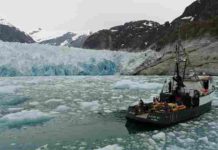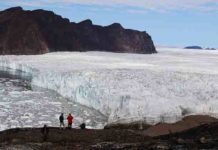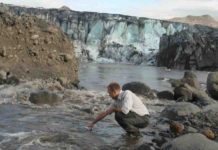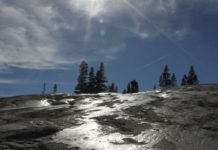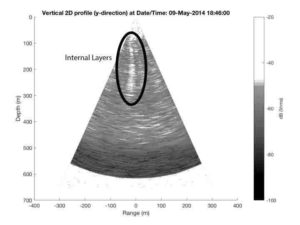
Stanford scientists have revealed the presence of water stored within a glacier in Greenland, where the rapidly changing ice sheet is a major contributor to the sea-level rise North America will experience in the next 100 years. This observation — which came out of a new way of looking at existing data — has been a missing component for models aiming to predict how melting glaciers will impact the planet.
The group made the discovery looking at data intended to reveal the changing shape of Store Glacier in West Greenland. But graduate student Alexander Kendrick figured out that the same data could measure something much more difficult to observe: its capacity to store water. The resulting study, published in Geophysical Research Letters, presents evidence of glacier meltwater from the surface being stored within damaged, solid ice. While ice melting at the surface has been well documented, little is known about what happens below glacier surfaces, and this observation of liquid water stored within solid ice may explain the complex flow behavior of some Greenland glaciers.
“Things like this don’t always come along, but when they do, that is the real ‘joy of the discovery’ component of Earth science,” said co-author Dustin Schroeder, an assistant professor of geophysics at Stanford University’s School of Earth, Energy & Environmental Sciences (Stanford Earth). “This paper not only highlights this component’s existence, but gives you a way to observe it in time.”
Surface meltwater plays an important role in Greenland by lubricating the bottoms of ice sheets and impacting how retreating glaciers are affected by the ocean. The process of how the glaciers melt and where the water flows contributes to their behavior in a changing climate, as these factors could alter glaciers’ response to melting or impact the timeline for sea-level rise. Knowing that some liquid is intercepted within glaciers after melting on the surface may help scientists more accurately predict oceanic changes and help people prepare for the future, Schroeder said.
“All of our predictions of sea-level rise are missing this meltwater component,” Schroeder said. “I think we’re only just realizing how important it is to understand at a fundamental physical scale what glacier meltwater does on its way from the surface to the bed.”
A different perspective
The researchers analyzed data from a high-resolution, low-power radio-echo sounder (ApRES) collected hourly from May to November 2014. Behaving like an ultrasound for ice, the radar sends an electronic wave that bounces off variations in ice density to create an image of ice structure that shows how quickly the ice melts or moves over time.
When the team plotted the radar data, it looked suspicious, said Kendrick, who was lead author on the paper. They tested ideas such as temperature variations and battery fluctuations to account for what they saw, then wondered if water within the ice was causing the peculiarity. By looking at a different aspect of the data, Kendrick noticed that the idiosyncrasies coming from deep within the glacier correlated with information from a nearby weather station indicating that the glacier had been melting at the time the data was collected. That finding backed up the idea that they were detecting water that had melted on the surface and then trickled down into the glacier, where it got trapped.
“This is a new way you could use these instruments to answer scientific questions — instead of just looking at changes in the ice thickness, we’re also looking at changes in the ice properties itself,” said co-author Winnie Chu, a postdoctoral researcher in Schroeder’s lab. “Alex set up the groundwork for trying to understand how this meltwater storage changes through time.”
The study reveals a significant amount of meltwater produced from the local area surrounding the radar is being intercepted and stored within the ice in a region extending between 15 to 148 feet below the surface during the summer, then released or refrozen during winter.
“The water system of Greenland is critical for understanding what’s happening on the planet,” said Schroeder, who is also a fellow at the Stanford Woods Institute for the Environment. “This component Alex has discovered shows that there is a piece of this glacier in particular — and maybe the entire Greenland hydrologic system in general — that we just were not modeling or thinking about in this way.”
The researchers hope this new geophysical method can be used to understand how meltwater impacts other glaciers and glacial systems, as well.
Reference:
A. K. Kendrick, D. M. Schroeder, W. Chu, T. J. Young, P. Christoffersen, J. Todd, S. H. Doyle, J. E. Box, A. Hubbard, B. Hubbard, P. V. Brennan, K. W. Nicholls, L. B. Lok. Surface Meltwater Impounded by Seasonal Englacial Storage in West Greenland. Geophysical Research Letters, 2018; DOI: 10.1029/2018GL079787
Note: The above post is reprinted from materials provided by Stanford’s School of Earth, Energy & Environmental Sciences.


